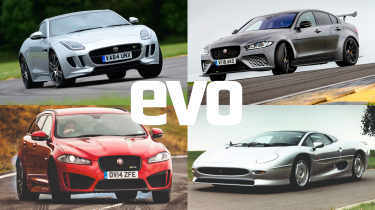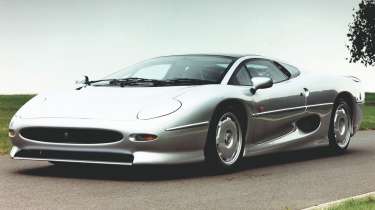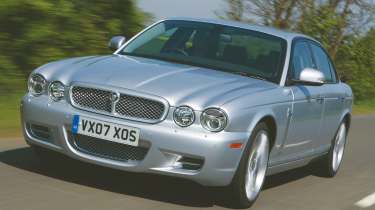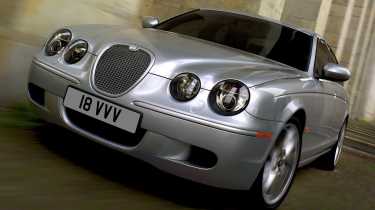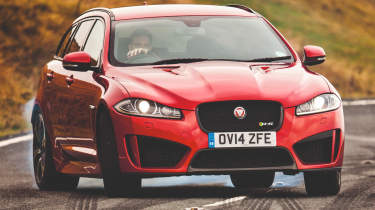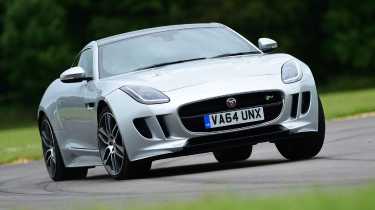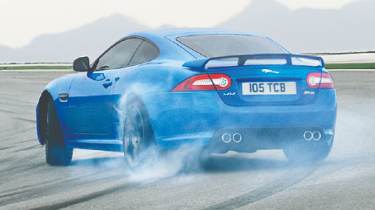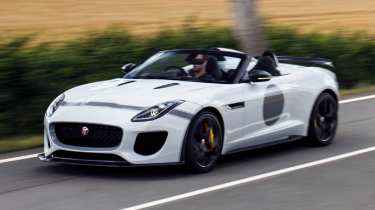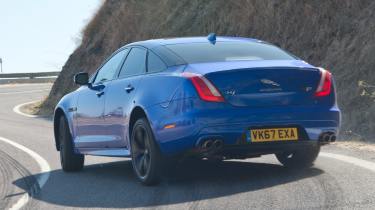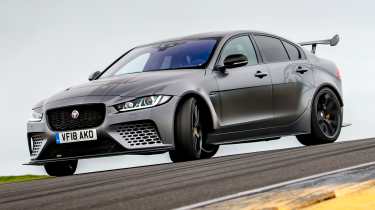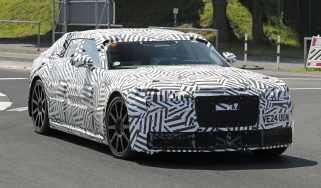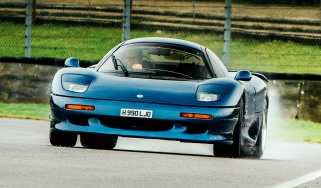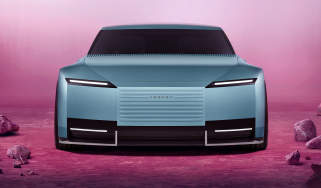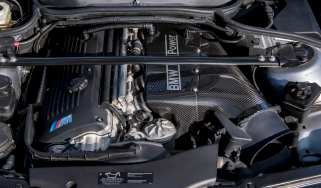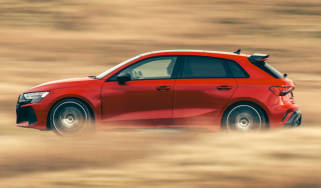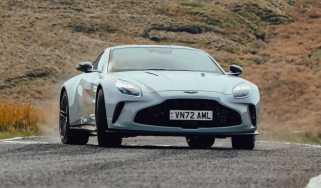Best Jaguars – big cats that defined the breed
As Jaguar stares down the barrel of a polarising new era, it’d do well not to forget some of the brilliance from its past. We list Jag’s modern greats.
Now that the Type 00 Concept has been revealed, Jaguar’s reinvention is at hand. Or at least, it’ll be at hand in around a year, when the first production car of this new premium EV era for the leaping cat arrives. Love it or lump it, there is a line in the sand between this concept and what’s to come, and the cars of Jaguar’s past. Looking back, we pick out a selection of our favourite models from that storied lineage.
> 'Jaguar’s rebrand isn’t the problem, its new cars will be'
It’s a company that’s been through a few iterations and transformations, not just since its foundation as SS Cars in 1933, but over the last few decades. Our list will focus primarily on evo era cars. That’s to say, it won’t start with the SS100 and finish with the Mark 10. That being said, we can’t not mention a few because it's off the back of the legacy these cars helped forge, that Jaguar can afford to be so bold today. The XKs were the top speed kings of their day and introduced the XK straight-six. The C-Type pioneered disc brakes, to Le Mans-winning effect. The D-Type stormed Le Mans making Jaguar the joint winningest marque around La Sarthe at the time of its last victory. The E-Type was the car that, upon seeing it, Enzo Ferrari proclaimed was the most beautiful ever made. The XJR-9 showed that Jaguar engines could still power a Le Mans win. It’s these cars and more that laid the foundations for a premium performance marque and a range of products that evo came to love over the years.
Jaguar XJ220
A significant landmark car in Jaguar’s history, the XJ220 supercar is still a legend today. By achieving 212.4 mph, it was the fastest production of all time until the McLaren F1 arrived.
The XJ220 benefitted from technology derived from Jaguar’s sportscar racing successes. Thanks to a 3.5-litre twin turbocharged Metro 6R4-derived V6 engine, the XJ220 produced 540bhp and could get to 60mph in just 3.6 seconds. Performant though it was, it never quite lived up to its initial promise, both in terms of its execution and sales performance. It never received the V12 race engine it was first promised, nor the all-wheel-drive system or Lamborghini-aping scissor doors, and as such many buyers that registered interest in the first instance, disappeared into the aether. It never even managed the 220mph top speed it was named for.
Nevertheless, it is a proper old-school supercar – dramatic, intimidating, vast in footprint and less than friendly in anything but ideal conditions. Its big laggy turbochargers, gruff V6 and industrial manual transmission add to the experience too. The XJ220 is typical of an era defined by an addiction to absolute power, forged by any means.
Jaguar XJR
Jaguar’s not a supercar company, though, is it? That’s our formal response to anyone wondering why we’ve gone straight from the XJ220, to the XJR of the 2000s. It was a sporting saloon car company and the XJ is arguably the defining model of that breed. There are plenty of candidates for ‘peak XJ’, and the X350 XJR is surely right up there.
The fitment of a 400bhp 4.2-litre supercharged V8 in a relatively light, alloy-bodied, alloy-chassised saloon was always going to be a potent mixture. But what made the XJR special was that it was a proper Jag – it rode beautifully, was well balanced, crisp in its responses and thanks to its lightweight construction, was a swift thing. In truth, the vestigial (if still handsome) design did the excellent car underneath a total disservice.
Jaguar S-Type R
To look at the Jaguar S-Type has never been a winner but time has eased the guttural response one used to have upon seeing one. And the dark horse of the range was of course the S-Type R. Big wheels, beefy brakes, purposeful exhausts, smoky lights and dulled brightwork did much to inject a bit of punch to Jag’s dorky 5-series rival.
To drive too, it was a sly charmer – never the car to administer the M5 a definitive shiner but always difficult to dismiss on objective merit alone. It was fast, with the same 400bhp 4.2-litre supercharged V8 as the XJR. It handled well too, thanks to its performance-tuned adaptive suspension. Like the XJR above, it quite literally formed the foundation (their platforms lived on in the next XJ and the XF) of Jaguar’s more agreeable-looking next-gen product, which had much to thank these solid underpinnings for.
Jaguar XFR-S Sportbrake
Familiar though the platforms may have been, Jaguar in 2014 was unrecognisable compared to Jaguar of a decade before. Never was that more evident, than when considering the XFR-S Sportbrake. If the S-Type R was the start of the marque’s attempts to do battle with the BMW M5, the Jaguar XFR-S is the concluding final flourish, with the second-gen XF that followed never getting the full-on performance treatment.
Possibly one of the best looking family cars of all time, the Jaguar XFR-S Sportbrake paired its infallible good looks with 542bhp of 5-litre supercharged V8 muscle and dynamics to charm objectivity out of the equation. For as ever, the Germans did it a bit better – the Mercedes-AMG E63 of the time was a bit faster, a bit more responsive, a bit more controlled and featured a sturdier diff. But the Jag had heart and oodles of talent all of its own, riding well enough but packing the punch of a gentleman brawler, as a Jag should. As we summarised in our review: ‘The handsome XF Sportbrake estate with Jaguar's most potent, 542bhp supercharged V8 and Nürburgring-developed chassis upgrades. What's not to like?’
Jaguar F-Type R
Jaguar has always been the underdog that we hoped would one day win. With the first F-Type R, only the Ferrari 458 Speciale, one of the greatest performance cars of all time, kept it off the top step at evo Car of the Year 2014. But that runner-up position saw it finish ahead of the Porsche Cayman GTS, Renault Megane Trophy-R and Aston Martin Vanquish.
The F-Type is perhaps the definitive Jag – purposeful yet classy, brutal yet beautiful, with all of the bite to match its quite considerable bark. The crackles of the frankly ridiculous exhaust fitted to that 542bhp, 501lb ft supercharged V8 echo throughout the Scottish borders ten years on from that eCoty test. It was a car for all occasions – astonishingly fast and enormously entertaining, with the pliancy and appointment to cosset on the long schlep home. It’s the car everyone misses as they stare down the barrel of this new silent, electric era for Jaguar. Quite how anything like its addictive personality will be instilled into the new cars is anyone’s guess.
Jaguar XKR-S
With as much power as the XJ220 and borderline garish visuals to match, the XKR-S was a real sign of intent from Jaguar. It was clear that the firm wanted to shake its reputation of middle aged, mildly quick, luxury performance cars. Instead, it wanted to re-enter the high performance market with a bang.
The XKR-S received an additional 39bhp over the standard XKR, for 542bhp, and the suspension was beefed up thanks to development on the Nürburgring. Visually, the car was as striking as it was loud. The XKR-S received a whole host of visual upgrades aimed at improving aerodynamics and looks. With a large front splitter and general body kit all round, it's instantly distinguishable from the standard car and alarmingly aggressive. We loved how it felt so pure, less synthetic and refreshingly analogue compared to the standard XKR. Not as lithe as a 911 GT3, but exciting, thrilling and a demonstration of how far Jaguar can go when it lets its hair down.
Jaguar F-Type Project 7
If the F-Type R was extreme, the F-Type Project 7 was another level. The launch pad for the Jaguar’s Special Vehicle Operations department, in essence the Project 7 was an F-Type unplugged. A no nonsense unhinged version with no restrictions.
With 567bhp it was the most powerful car that Jaguar had ever produced. The car was built as a homage to great cars within Jaguar’s back catalogue. The C-Type and D-Type that forged Jaguar’s legend at Le Mans are clear influences, with more than a little of the D-Type’s stabilising fin in the Project 7’s single muscular rear haunch. Yet despite heavily altered looks, the car remains unmistakably an F-Type and an enhancement of the base car’s blend of boldness and beauty.
> Jaguar F-Type (2020 - 2024) facelift review – flying the flag for the great British sports car
It’s phenomenally fast but the Project 7 is also huge fun due to the lairy nature of its rear end. Was it a missed opportunity to create the ultimate sharp F-Type, to properly rival the 911 GT3? Potentially but then, such a car isn’t something we expect of Jaguar. We do expect style, performance and flamboyance and the painfully rare F-Type Project 7 has that all in spades.
Jaguar XJR575
The Jaguar XJR575 represents the final roar for Jag’s big limo (denied as it was reincarnation as an EV) and an example of the long-standing breed at its absolute best. Big on performance, brilliantly balanced, subtle yet sexy on style, it’s the XJ as we ever knew it, but more. Packing what had become the ubiquitous 5-litre supercharged V8, it had a full-bodied 567bhp and 517lb ft to deploy. It could do 186mph, hitting 62mph in 4.4sec on the way there. But as always it’s not the headline figures that impress in an XJ, it’s how it carries itself. For its size and its segment, the XJR575 is far more fun, with a good driving position, good platform control and strong braking. When we first tested it in 2018 on road and track, it enthralled and engaged in every scenario we put it through:
‘What makes the 575 so special is its ability to effectively shrink around the driver. Rather than unleash a terrifying amount of tech to make a big car do things it really shouldn’t be able to do, the 575 relies instead on a more traditional recipe of feedback, chassis balance and depth of character to not only entertain, but to draw you relentlessly into the experience.’
Jaguar XE SV Project 8
Arguably modern Jaguar’s crowning achievement, the near-600bhp XE SV Project 8 truly was Jaguar unplugged. You have to wonder how such an extreme, specialised supersaloon was ever given the green light. The modified bodywork, the bulkhead changes in order to fit the V8, the fact it had to be a left-hooker only, the overhauled suspension, all represented costs that even the most profitable of companies would struggle to justify. But we’re so glad Jaguar chose not to compromise, because the all-out approach is worn on the Project 8’s sleeve at every turn.
> BMW M3 CS v Alfa Romeo Giulia GTA v Jaguar XE Project 8 – supersaloon specials go head-to-head
The suspension changes are an example of just how comprehensive the makeover was. The Project 8 got bespoke billet knuckles to allow greater camber adjustment and a rose-jointed rear upper arm assembly. It had adjustable anti-roll bars, adjustable spring platforms to choose between track- and road-focused ride heights. Then you look at the proportions, with 24mm and 73mm wider front and rear tracks, respectively. In fact, every panel bar the roof and door skins were changed. It’s the opposite of something like an M5 CS, which seems to conjure astonishing feel, feedback and driving sensation out of nowhere. The Jag by comparison, delivers an experience that entirely lives up to the looks and the laundry list of modifications. And yet when not on a full-snarl mountain road thrash, it’s supple enough, refined enough and with good enough manners to still be a usable Jag.
To go from this, to where we are now in the space of six years, feels very strange indeed. But there are similarities between the P8 and what we’ve seen in the Type 00 – a lack of compromise, a singularity of vision. Is the Type 00’s vision quite up our alley like the Project 8 was? Of course not, but as the P8 proved, Jaguar is at its best when it’s being bold. Whatever’s in store for Jag going forward, it certainly won’t be dull.

